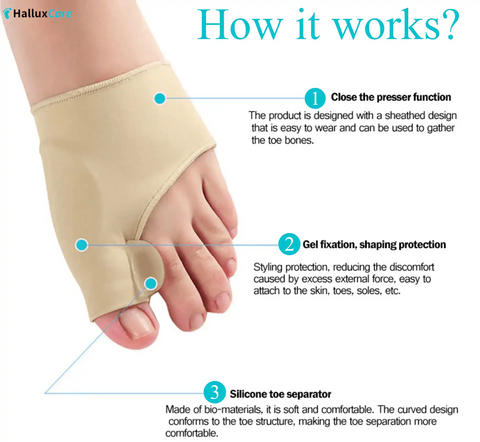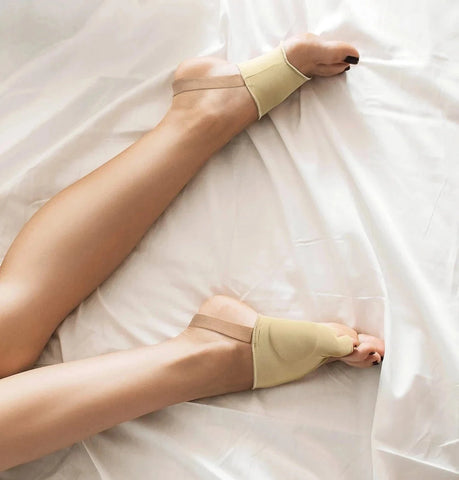Non-Surgical Bunion Treatment: Real People, Real Relief
Last Updated: June 2025 | Written by: Dr. Hannah Lee, DPM – Board-Certified Podiatrist
Living with bunions can be painful, frustrating, and limiting. While bunion surgery (bunionectomy) is an option for some, many individuals prefer or require non-surgical bunion treatment due to medical, financial, or lifestyle reasons. One Reddit user summed it up well: “I can’t have metal implants, so no bunion surgery or artificial joints ever. I do lots of yoga, and walk a lot with corrective footwear, and it has helped a ton.”
This article explores non-invasive, evidence-based bunion solutions—ranging from orthopedic aids to lifestyle adjustments—supported by real-life stories, medical insight, and practical tools.
Key Takeaways
- Non-surgical treatments can significantly reduce bunion pain and improve foot alignment with consistent use.
- Options like toe spacers, supportive footwear, and therapeutic exercises are backed by podiatric research.
- Medical-grade products and natural remedies offer safe, affordable alternatives to surgery.
- Real users report improved mobility, reduced pain, and better sleep without invasive procedures.
Disclaimer & Disclosure
This content is for informational purposes only and is not a substitute for professional medical advice, diagnosis, or treatment. Always consult a healthcare provider regarding your specific condition. This article contains affiliate links to HalluxCare products, from which we may earn a small commission at no additional cost to you if you make a purchase.
Why People Choose Non-Surgical Bunion Solutions
A bunion, medically known as hallux valgus, is a deformity where the big toe shifts toward the second toe, causing a painful bony bump at the base of the big toe joint. Non-surgical approaches are increasingly favored due to:
- Medical restrictions: Some individuals cannot undergo surgery due to allergies to metal implants or chronic conditions that complicate healing (e.g., diabetes or vascular disease).
- Extended recovery time: Bunion surgery often requires 6–12 weeks of downtime, which may not be feasible for active individuals or those with caregiving responsibilities.
- Variable outcomes and cost: While effective for some, surgery doesn’t guarantee complete relief and can be costly without insurance coverage.
For many, combining conservative strategies can help relieve symptoms and slow bunion progression.
Conservative Bunion Treatment That Really Works
1. Corrective Footwear
Wearing shoes with a wide toe box, low heel, and strong arch support helps redistribute pressure across the foot and reduces stress on the bunion joint. According to the American College of Foot and Ankle Surgeons (ACFAS), proper footwear plays a key role in symptom management and bunion progression control.1
2. Toe Spacers and Alignment Sleeves
Toe spacers gently realign the big toe, helping to reduce friction, improve joint positioning, and relieve pain during daily activities or sleep. Medical-grade sleeves provide targeted pressure distribution and cushioning around the joint.
4.9 ⭐⭐⭐⭐⭐ ( 1843 reviews )
3. Yoga and Foot Exercises
Manual foot exercises and yoga improve flexibility and muscle strength in the feet and lower legs. These movements can help stabilize the foot and reduce the inward pull that causes bunion formation. Podiatrists often recommend exercises like:
- Toe stretches: Gently stretch and extend the big toe away from the second toe.
- Marble pickups: Strengthen foot muscles by picking up small objects with your toes.
- Downward dog pose: Promotes calf and foot flexibility while improving balance.
4. Anti-Inflammatory Care
- Use ice therapy (15–20 minutes, 2–3 times daily) to reduce joint inflammation and swelling.
- Apply natural Jamaica Black Castor Oil to sore areas for its anti-inflammatory and skin-soothing effects.
Real People, Real Results
Many individuals have found success with consistent, non-surgical strategies. Real user testimonials from forums like Reddit and product reviews show measurable improvements in bunion-related issues:
Tips from the Community:
- “Walking in minimalist shoes helped me strengthen my foot muscles.”
- “Daily yoga made a huge difference in my flexibility and pain levels.”
- “Using bunion sleeves at night keeps my toe aligned, and I sleep better.”
These lived experiences align with recommendations from foot and ankle specialists, who often suggest conservative care as a first-line treatment for mild-to-moderate bunions.
Start Your Non-Surgical Journey Today
Managing bunions doesn’t require surgery in every case. By combining podiatrist-approved tools, foot-strengthening exercises, and inflammation management, you can experience real relief and stay active without invasive procedures.
Recommended HalluxCare Products for Bunion Support
- Orthopedic Bunion Pain Relief & Correction Sleeve – Provides comfortable toe alignment and daily joint protection.
- Tailor's Bunion Bunionette Pain Relief Sleeves – Designed to protect the fifth toe (bunionette) with soft cushioning and alignment support.
- Jamaica Black Castor Oil Soothing Oil – Nourishes skin, reduces inflammation, and doubles as a natural remedy for joint discomfort and hair health.
FAQs: Non-Surgical Bunion Treatment
Q: Can bunions go away without surgery?
A: No, bunions do not reverse on their own, but non-surgical treatments can relieve pain, improve alignment, and prevent further progression.2
Q: How long does it take to see results from bunion sleeves?
A: Many users report reduced pain and better toe alignment within 2–4 weeks of consistent use. Long-term results depend on daily wear and other lifestyle changes.
Q: Are custom orthotics better than over-the-counter options?
A: Custom orthotics are tailored to your foot structure and may offer better support for severe deformities. However, many over-the-counter bunion sleeves and inserts work well for mild-to-moderate cases.
Q: When should I see a podiatrist?
A: If you experience persistent pain, difficulty walking, or worsening alignment despite conservative care, consult a podiatrist for evaluation and possible imaging.
What’s Your Approach to Bunion Relief?
Are you managing bunions without surgery? What tools or routines help you the most? Share your story or tips in the comments—we’d love to hear how you’re staying active and pain-free through conservative care.
References
- American College of Foot and Ankle Surgeons. “Hallux Valgus (Bunion) – Diagnosis and Treatment.” www.acfas.org
- American Podiatric Medical Association. “Bunions.” www.apma.org
Author: Dr. Hannah Lee, DPM is a board-certified podiatrist with over 10 years of clinical experience treating foot deformities, including bunions, through both surgical and non-surgical methods.




